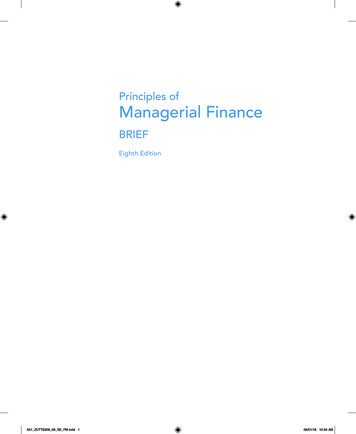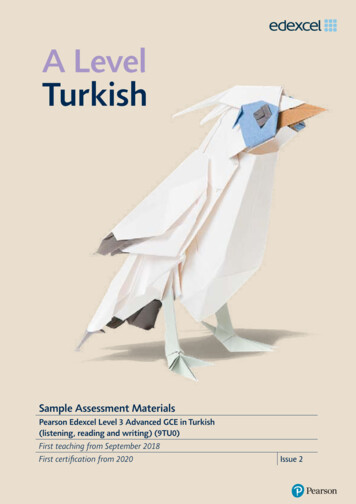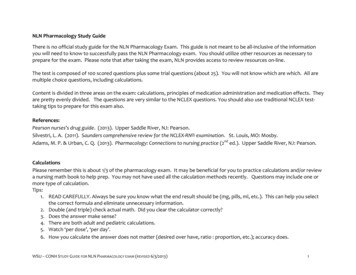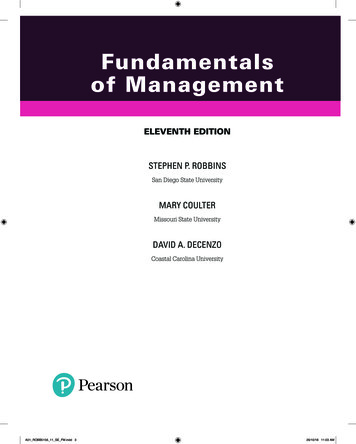
Transcription
Principles ofManagerial FinanceBRIEFEighth EditionA01 ZUTT6308 08 SE FM.indd 108/01/18 10:50 AM
The Pearson Series in FinanceBerk/DeMarzoCorporate Finance*Corporate Finance: The Core*HoldenExcel Modeling in Corporate FinanceExcel Modeling in InvestmentsRejda/McNamaraPrinciples of Risk Management andInsuranceBerk/DeMarzo/HarfordFundamentals of Corporate Finance*Hughes/MacDonaldInternational Banking: Text and CasesSmart/Gitman/JoehnkFundamentals of Investing*BrooksFinancial Management: CoreConcepts*HullFundamentals of Futuresand Options MarketsOptions, Futures, and OtherDerivativesSolnik/McLeaveyGlobal InvestmentsCopeland/Weston/ShastriFinancial Theory and CorporatePolicyDorfman/CatherIntroduction to Risk Management andInsuranceEakins/McNallyCorporate Finance OnlineEiteman/Stonehill/MoffettMultinational Business Finance*FabozziBond Markets: Analysis and StrategiesFoersterFinancial Management: Concepts andApplications*FrascaPersonal FinanceHaugenThe Inefficient Stock Market: WhatPays Off and WhyModern Investment TheoryKeownPersonal Finance: Turning Money intoWealth*Keown/Martin/PettyFoundations of Finance: TheLogic and Practice of FinancialManagement*MaduraPersonal Finance*McDonaldDerivatives MarketsFundamentals of Derivatives MarketsTitman/MartinValuation: The Art and Science ofCorporate Investment DecisionsWeston/Mitchell/MulherinTakeovers, Restructuring, andCorporate GovernanceZutter/SmartPrinciples of Managerial Finance*Principles of Managerial Finance—Brief Edition*Mishkin/EakinsFinancial Markets and InstitutionsMoffett/Stonehill/EitemanFundamentals of MultinationalFinance*PennacchiTheory of Asset Pricing* denotes titles with MyLab Finance.A01 ZUTT6308 08 SE FM.indd 2Titman/Keown/MartinFinancial Management: Principles andApplications*Log onto www.pearson.com/mylab/finance to learn more.02/01/18 5:45 PM
EIGHTH EDITIONPrinciples ofManagerial FinanceBRIEFChad J. ZutterUniversity of PittsburghScott B. SmartIndiana UniversityNew York, NYA01 ZUTT6308 08 SE FM.indd 302/01/18 5:45 PM
Vice President, Business, Economics, and UK Courseware: DonnaBattistaDirector of Portfolio Management: Adrienne D’AmbrosioSenior Portfolio Manager: Kate FernandesEditorial Assistant: Caroline FennVice President, Product Marketing: Roxanne McCarleyProduct Marketer: Kaylee CarlsonProduct Marketing Assistant: Marianela SilvestriManager of Field Marketing, Business Publishing: AdamGoldsteinExecutive Field Marketing Manager: Thomas HaywardVice President, Production and Digital Studio, Arts and Business:Etain O’DeaDirector of Production, Business: Jeff HolcombManaging Producer, Business: Alison KalilContent Producer: Meredith GertzOperations Specialist: Carol MelvilleDesign Lead: Kathryn FootManager, Learning Tools: Brian SuretteContent Developer, Learning Tools: Sarah PetersonManaging Producer, Digital Studio and GLP, Media Productionand Development: Ashley SantoraManaging Producer, Digital Studio: Diane LombardoDigital Studio Producer: Melissa HonigDigital Studio Producer: Alana ColesDigital Content Team Lead: Noel LotzDigital Content Project Lead: Miguel LeonarteProject Manager: Kathy Smith, Cenveo Publisher ServicesInterior Design: Cenveo Publisher ServicesCover Design: Cenveo Publisher ServicesCover Art: ChristopheHeylen/DigitalVision Vectors/Getty Images;Decha Anunthanapong/123RF; John Kuczala/DigitalVision/Getty Images; Sean Russell/Getty Images; MarsBars/E /GettyImages; Panuwat Phimpha/ShutterstockPrinter/Binder: LSC Communications, Inc./KendallvilleCover Printer: Phoenix Color/HagerstownMicrosoft and/or its respective suppliers make no representations about the suitability of the information contained in the documents andrelated graphics published as part of the services for any purpose. All such documents and related graphics are provided “as is” withoutwarranty of any kind. Microsoft and/or its respective suppliers hereby disclaim all warranties and conditions with regard to this information, including all warranties and conditions of merchantability, whether express, implied or statutory, fitness for a particular purpose, titleand non-infringement. In no event shall Microsoft and/or its respective suppliers be liable for any special, indirect or consequential damagesor any damages whatsoever resulting from loss of use, data or profits, whether in an action of contract, negligence or other tortious action,arising out of or in connection with the use or performance of information available from the services.The documents and related graphics contained herein could include technical inaccuracies or typographical errors. Changes are periodically added to the information herein. Microsoft and/or its respective suppliers may make improvements and/or changes in theproduct(s) and/or the program(s) described herein at any time. Partial screen shots may be viewed in full within the software versionspecified.Microsoft and Windows are registered trademarks of the Microsoft Corporation in the U.S.A. and other countries. This book is notsponsored or endorsed by or affiliated with the Microsoft Corporation.Copyright 2019, 2015, 2012 by Pearson Education, Inc. or its affiliates. All Rights Reserved. Manufactured in the United States ofAmerica. This publication is protected by copyright, and permission should be obtained from the publisher prior to any prohibited reproduction, storage in a retrieval system, or transmission in any form or by any means, electronic, mechanical, photocopying, recording, orotherwise. For information regarding permissions, request forms, and the appropriate contacts within the Pearson Education Global Rightsand Permissions department, please visit www.pearsoned.com/permissions/.Acknowledgments of third-party content appear on the appropriate page within the text.PEARSON, ALWAYS LEARNING, and MYLAB are exclusive trademarks owned by Pearson Education, Inc. or its affiliates in the U.S.and/or other countries.Unless otherwise indicated herein, any third-party trademarks, logos, or icons that may appear in this work are the property of theirrespective owners, and any references to third-party trademarks, logos, icons, or other trade dress are for demonstrative or descriptivepurposes only. Such references are not intended to imply any sponsorship, endorsement, authorization, or promotion of Pearson’s products by the owners of such marks, or any relationship between the owner and Pearson Education, Inc., or its affiliates, authors, licensees,or distributors.Cataloging-in-Publication Data is available on file at the Library of Congress118A01 ZUTT6308 08 SE FM.indd 4ISBN 10: 0-13-447630-1ISBN 13: 978-0-13-447630-802/01/18 5:45 PM
Dedicated to our good friend and mentor,Dr. Lawrence J. Gitman,who trusted us as coauthors and successorsof Principles of Managerial Finance, Brief Edition.CJZSBSA01 ZUTT6308 08 SE FM.indd 508/01/18 10:50 AM
A01 ZUTT6308 08 SE FM.indd 602/01/18 5:45 PM
Brief ContentsContents ixAbout the Authors xxvPreface xxviiAcknowledgments xlPART 1 Introduction to ManagerialFinance 112713 Financial Statements and Ratio Analysis4 Long- and Short-Term FinancialPlanning 137Time Value of Money 183PART 3 Valuation of Securities6772Leverage and Capital Structure 506Payout Policy 558PART 7 Short-Term FinancialDecisions 59314 Working Capital and Current Assets15Management 594Current Liabilities Management 636243Interest Rates and Bond Valuation 244Stock Valuation 291PART 4 Risk and the Required Rate ofReturn 327891213The Role of Managerial Finance 2The Financial Market Environment 39PART 2 Financial Tools5PART 6 Long-Term FinancialDecisions 505Appendix A-1Glossary G-1Index I-1Risk and Return 328The Cost of Capital 376PART 5 Long-Term InvestmentDecisions 40510 Capital Budgeting Techniques 40611 Capital Budgeting Cash Flows and RiskRefinements 445viiA01 ZUTT6308 08 SE FM.indd 702/01/18 5:45 PM
A01 ZUTT6308 08 SE FM.indd 802/01/18 5:45 PM
ContentsAbout the Authors xxvPreface xxviiAcknowledgments xlPART 1 Introduction to Managerial Finance1The Role ofManagerialFinance 21.11Finance and the Firm 3What Is Finance? 3What Is a Firm? 4What Is the Goal of the Firm? 4The Role of Business Ethics 8in practiceFOCUS ON PRACTICE:Must Search Engines Screen Out FakeNews? 10 REVIEW QUESTIONS 101.2Managing the Firm 101.4 Developing Skills for YourCareer 30Critical Thinking 30Communication and Collaboration 31Financial Computing Skills 31Summary 31Self-Test Problem 33Warm-Up Exercises 33Problems 35Spreadsheet Exercise 38The Managerial Finance Function 11 REVIEW QUESTIONS 191.3 Organizational Forms, axation, and the Principal-AgentT Relationship 19Legal Forms of Business Organization 19Agency Problems and Agency Costs 26Corporate Governance 26 REVIEW QUESTIONS 30ixA01 ZUTT6308 08 SE FM.indd 902/01/18 5:45 PM
xContents2The FinancialMarketEnvironment2.139Financial Institutions 402.4The Securities IssuingProcess 53Commercial Banks, Investment Banks,and the Shadow Banking System 40Issuing Common Stock 53 REVIEW QUESTIONS 42 REVIEW QUESTIONS 612.2Financial Markets 42The Relationship Between Institutionsand Markets 42The Money Market 43The Capital Market 44The Role of Capital Markets 48in practiceFOCUS ON ETHICS:Should Insider Trading Be Legal? 50 REVIEW QUESTIONS 512.3 Regulation of Financial Marketsand Institutions 512.5Financial Markets in Crisis 61Financial Institutions and Real EstateFinance 62Spillover Effects and Recovery from theGreat Recession 64 REVIEW QUESTIONS 65Summary 65Self-Test Problem 67Warm-Up Exercises 68Problems 68Spreadsheet Exercise 70Regulations Governing FinancialInstitutions 51Regulations Governing FinancialMarkets 52 REVIEW QUESTIONS 53A01 ZUTT6308 08 SE FM.indd 1002/01/18 5:45 PM
Contents xiPART 2 Financial Tools3FinancialStatements andRatio Analysis 723.171The Stockholders’ Report 73The Letter to Stockholders 73The Four Key Financial Statements 73in practiceFOCUS ON ETHICS:Earnings Shenanigans 74Notes to the Financial Statements 80Consolidating International FinancialStatements 80 REVIEW QUESTIONS 813.2Using Financial Ratios 82Interested Parties 82Types of Ratio Comparisons 82Cautions About Using Ratio Analysis 85 REVIEW QUESTIONS 863.3Liquidity Ratios 87Current Ratio 87Quick (Acid-Test) Ratio 89 REVIEW QUESTIONS 903.4Activity Ratios 90Inventory Turnover 90Average Collection Period 91Average Payment Period 93Total Asset Turnover 93 REVIEW QUESTION 943.5Debt Ratios 94Debt Ratio 96Debt-to-Equity Ratio 96A01 ZUTT6308 08 SE FM.indd 11Times Interest Earned Ratio 97Fixed-Payment Coverage Ratio 98 REVIEW QUESTIONS 983.6Profitability Ratios 98Common-Size Income Statements 98Gross Profit Margin 99Operating Profit Margin 101Net Profit Margin 101Earnings Per Share (EPS) 102Return on Total Assets (ROA) 103Return on Equity (ROE) 103 REVIEW QUESTIONS 1053.7Market Ratios 105Price/Earnings (P/E) Ratio 106Market/Book (M/B) Ratio 108 REVIEW QUESTION 1093.8A Complete Ratio Analysis 109Summary of Whole Foods’ Financial Condition 109DuPont System of Analysis 113 REVIEW QUESTIONS 116Summary 116Self-Test Problems 118Warm-Up Exercises 119Problems 120Spreadsheet Exercise 13502/01/18 5:45 PM
xiiContents4Long- and ShortTerm FinancialPlanning 1374.14.4The Financial PlanningProcess 138Profit Planning: Pro FormaStatements 159Long-Term (Strategic) Financial Plans 138Short-Term (Operating) FinancialPlans 139Preceding Year’s Financial Statements 160Sales Forecast 160 REVIEW QUESTION 161 REVIEW QUESTIONS 1404.24.5Measuring the Firm’s CashFlow 140Depreciation 140Depreciation Methods 141Developing the Statement of CashFlows 143Free Cash Flow 148in practiceFOCUS ON ETHICS:Is Excess Cash Always a GoodThing? 149 REVIEW QUESTIONS 1504.3Cash Planning: CashBudgets 151The Sales Forecast 151Preparing the Cash Budget 151Evaluating the Cash Budget 156Coping with Uncertainty in the CashBudget 157Cash Flow within the Month 159Preparing the Pro FormaIncome Statement 161Considering Types of Costs andExpenses 162 REVIEW QUESTIONS 1634.6 Preparing the Pro FormaBalance Sheet 163 REVIEW QUESTIONS 1654.7Evaluation of Pro FormaStatements 165 REVIEW QUESTIONS 166Summary 166Self-Test Problems 168Warm-Up Exercises 170Problems 170Spreadsheet Exercise 181 REVIEW QUESTIONS 159A01 ZUTT6308 08 SE FM.indd 1202/01/18 5:45 PM
Contents xiii5Time Value ofMoney 1835.15.5The Role of Time Value inFinance 184Compounding Interest MoreFrequently Than Annually 208Future Value Versus Present Value 184Computational Tools 185Basic Patterns of Cash Flow 187Semiannual Compounding 208Quarterly Compounding 209A General Equation forCompounding 210Using Computational Tools forCompounding 210Continuous Compounding 211Nominal and Effective Annual Rates ofInterest 212 REVIEW QUESTIONS 1875.2Single Amounts 188Future Value of a Single Amount 188Present Value of a Single Amount 192 REVIEW QUESTIONS 195 EXCEL REVIEW QUESTIONS 1955.3Annuities 196Types of Annuities 196Finding the Future Value of an OrdinaryAnnuity 197Finding the Present Value of an OrdinaryAnnuity 198Finding the Future Value of an AnnuityDue 200Finding the Present Value of an AnnuityDue 201Finding the Present Value of aPerpetuity 203 REVIEW QUESTIONS 204 EXCEL REVIEW QUESTIONS 2045.4Mixed Streams 205Future Value of a Mixed Stream 205Present Value of a Mixed Stream 207 REVIEW QUESTION 208 REVIEW QUESTIONS 214in practiceFOCUS ON ETHICS:Was the Deal for Manhattan aSwindle? 214 EXCEL REVIEW QUESTIONS 2155.6 Special Applications ofTime Value 215Determining Deposits Needed toAccumulate a Future Sum 215Loan Amortization 216Finding Interest or Growth Rates 218Finding an Unknown Number ofPeriods 220 REVIEW QUESTIONS 222 EXCEL REVIEW QUESTIONS 222Summary 223Self-Test Problems 224Warm-Up Exercises 225Problems 226Spreadsheet Exercise 242 EXCEL REVIEW QUESTION 208A01 ZUTT6308 08 SE FM.indd 1302/01/18 5:45 PM
xivContentsPART 3 Valuation of Securities6Interest Ratesand BondValuation 2442436.1 Interest Rates and RequiredReturns 245Interest Rate Fundamentals 245Term Structure of Interest Rates 250Risk Premiums: Issuer and IssueCharacteristics 255 REVIEW QUESTIONS 2566.2Government and CorporateBonds 257Legal Aspects of Corporate Bonds 257Cost of Bonds to the Issuer 259General Features of a Bond Issue 259Bond Yields 260Bond Prices 260Bond Ratings 261Common Types of Bonds 261International Bond Issues 263in practiceFOCUS ON ETHICS:“Can Bond Ratings Be Trusted?” 263 REVIEW QUESTIONS 264A01 ZUTT6308 08 SE FM.indd 146.3Valuation Fundamentals 265Key Inputs 265Basic Valuation Model 266 REVIEW QUESTIONS 2676.4Bond Valuation 267Bond Fundamentals 268Bond Valuation 268Semiannual Interest Rates and BondValues 270Changes in Bond Values 272Yield to Maturity (YTM) 275 REVIEW QUESTIONS 277 EXCEL REVIEW QUESTIONS 277Summary 277Self-Test Problems 279Warm-Up Exercises 280Problems 281Spreadsheet Exercise 29002/01/18 5:45 PM
Contents xv77.1Differences Between DebtStock Valuation 291 and Equity 292Voice in Management 292Claims on Income and Assets 292Maturity 293Tax Treatment 293 REVIEW QUESTION 2937.2Common and PreferredStock 293Common Stock 294Preferred Stock 2977.4Decision Making and CommonStock Value 312Changes in Expected Dividends 313Changes in Risk 313Combined Effect 314 REVIEW QUESTIONS 314Summary 315Self-Test Problems 317Warm-Up Exercises 317Problems 318Spreadsheet Exercise 326 REVIEW QUESTIONS 2997.3Common Stock Valuation 299Market Efficiency and Stock Valuation 299Common Stock Dividend ValuationModel 301in practiceFOCUS ON PRACTICE:Understanding Human Behavior HelpsUs Understand Investor Behavior 302Free Cash Flow Stock Valuation Model 306Other Approaches to Common StockValuation 309 REVIEW QUESTIONS 312A01 ZUTT6308 08 SE FM.indd 1502/01/18 5:45 PM
xviContentsPART 4 Risk and the Required Rate of Return8Risk andReturn 3283278.1 Risk and ReturnFundamentals 3298.4 Risk and Return: The CapitalAsset Pricing Model (CAPM) 348What Is Risk? 329What Is Return? 329Risk Preferences 331Types of Risk 348The Model: CAPM 349 REVIEW QUESTIONS 3328.2Risk of a Single Asset 332Risk Assessment 332Risk Measurement 335 REVIEW QUESTIONS 3408.3 REVIEW QUESTIONS 358Summary 358Self-Test Problems 360Warm-Up Exercises 361Problems 362Spreadsheet Exercise 374Risk of a Portfolio 340Portfolio Return and StandardDeviation 340Correlation 342Diversification 343Correlation, Diversification, Risk, andReturn 345International Diversification 346in practiceGLOBAL FOCUS:An International Flavor to RiskReduction 347 REVIEW QUESTIONS 348A01 ZUTT6308 08 SE FM.indd 1602/01/18 5:45 PM
Contents xvii9The Cost ofCapital 3769.1Overview of the Cost ofCapital 377in practiceFOCUS ON ETHICS:The Cost of Capital Also Rises 377The Basic Concept 378Sources of Long-Term Capital 380 REVIEW QUESTIONS 3819.2Cost of Long-Term Debt 381Net Proceeds 381Before-Tax Cost of Debt 382After-Tax Cost of Debt 384 REVIEW QUESTIONS 385 EXCEL REVIEW QUESTION 3859.3Cost of Preferred Stock 385Preferred Stock Dividends 386Calculating the Cost of PreferredStock 3869.4Cost of Common Stock 386Finding the Cost of Common StockEquity 387Cost of Retained Earnings 390 REVIEW QUESTIONS 3919.5Weighted Average Costof Capital 391Calculating the Weighted Average Cost ofCapital (WACC) 391Capital Structure Weights 393 REVIEW QUESTIONS 394Summary 394Self-Test Problem 395Warm-Up Exercises 396Problems 397Spreadsheet Exercise 404 REVIEW QUESTION 386A01 ZUTT6308 08 SE FM.indd 1702/01/18 5:45 PM
xviiiContentsPART 5 Long-Term Investment Decisions4051010.1 Overview of Capital407BudgetingCapital BudgetingMotivesforCapitalExpenditure 407Techniques 406Steps in the Process 407Basic Terminology 408Capital Budgeting Techniques 409 REVIEW QUESTION 41010.2 Payback Period 410Decision Criteria 411Pros and Cons of Payback Analysis 411 REVIEW QUESTIONS 41410.3 Net Present Value (NPV) 414Decision Criteria 415NPV and the Profitability Index 416NPV and Economic Value Added 41710.5 Comparing NPV and IRRTechniques 422Net Present Value Profiles 422Conflicting Rankings 424Which Approach Is Better? 427in practiceFOCUS ON ETHICS:Baby You Can Drive My Car—Just Nota VW Diesel 429 REVIEW QUESTIONS 429Summary 430Self-Test Problem 431Warm-Up Exercises 432Problems 433Spreadsheet Exercise 443 REVIEW QUESTIONS 418 EXCEL REVIEW QUESTION 41810.4 Internal Rate of Return(IRR) 419Decision Criteria 419Calculating the IRR 419 REVIEW QUESTIONS 422 EXCEL REVIEW QUESTION 422A01 ZUTT6308 08 SE FM.indd 1808/01/18 10:51 AM
Contents xix11Capital BudgetingCash Flowsand RiskRefinements 44511.1 Project Cash Flows 446Major Cash Flow Types 446Replacement Versus ExpansionDecisions 447Sunk Costs and Opportunity Costs 448in practiceFOCUS ON ETHICS:Fumbling Sunk Costs 449 REVIEW QUESTIONS 45011.2 Finding the InitialInvestment 450Installed Cost of the New Asset 451After-Tax Proceeds from the Sale of theOld Asset 451Change in Net Working Capital 454Calculating the Initial Investment 455 REVIEW QUESTIONS 456 (Behavioral Approaches) 463Breakeven Analysis 464Scenario Analysis 466Simulation 467 REVIEW QUESTIONS 468 EXCEL REVIEW QUESTION 46811.6 Risk-Adjusted DiscountRates 468Determining Risk-Adjusted Discount Rates(RADRs) 469Applying RADRs 471Portfolio Effects 474RADRs in Practice 474 REVIEW QUESTIONS 47611.7 Capital Budgeting11.3 Finding the Operating CashRefinements 476Interpreting the Term Cash Flows 456Interpreting the Term After-Tax 457Interpreting the Term Incremental 459Comparing Projects with UnequalLives 476Recognizing Real Options 479Capital Rationing 480 REVIEW QUESTIONS 461 REVIEW QUESTIONS 483Flows 45611.4 Finding the Terminal CashFlow 461After-Tax Proceeds from the Sale of Newand Old Assets 461Change in Net Working Capital 462 REVIEW QUESTION 463A01 ZUTT6308 08 SE FM.indd 1911.5 Risk in Capital Budgeting EXCEL REVIEW QUESTION 483Summary 483Self-Test Problems 485Warm-Up Exercises 487Problems 489Spreadsheet Exercises 50408/01/18 10:51 AM
xxContentsPART 6 Long-Term Financial Decisions12Leverageand CapitalStructure 50650512.1 Leverage 507Breakeven Analysis 508Operating Leverage 511in practiceFOCUS ON PRACTICE:Qualcomm’s Leverage 514Financial Leverage 515Total Leverage 519 REVIEW QUESTIONS 52112.2 The Firm’s CapitalStructure 521Types of Capital 522External Assessment of CapitalStructure 522Capital Structure of Non–U.S. Firms 524Capital Structure Theory 525Optimal Capital Structure 53312.4 Choosing the Optimal CapitalStructure 539Linkage 539Estimating Value 540Maximizing Value Versus MaximizingEPS 540Some Other ImportantConsiderations 542 REVIEW QUESTIONS 543Summary 543Self-Test Problems 544Warm-Up Exercises 546Problems 546Spreadsheet Exercise 557 REVIEW QUESTIONS 53512.3 EBIT–EPS Approach toCapital Structure 536Presenting a Financing PlanGraphically 536Comparing Alternative CapitalStructures 537Considering Risk in EBIT–EPSAnalysis 538Basic Shortcoming of EBIT–EPSAnalysis 539 REVIEW QUESTION 539A01 ZUTT6308 08 SE FM.indd 2002/01/18 5:45 PM
Contents xxi13Payout Policy55813.1 The Basics of Payout Policy 559Elements of Payout Policy 559Trends in Earnings and Dividends 559Trends in Dividends and ShareRepurchases 561 REVIEW QUESTIONS 562in practiceFOCUS ON ETHICS:Buyback Mountain 56313.2 The Mechanics of PayoutPolicy 563Cash Dividend Payment Procedures 564Share Repurchase Procedures 566Tax Treatment of Dividends andRepurchases 567Dividend Reinvestment Plans 568Stock Price Reactions to CorporatePayouts 568 REVIEW QUESTIONS 56913.5 Types of Dividend Policies 575Constant-Payout-Ratio DividendPolicy 575Regular Dividend Policy 576Low-Regular-and-Extra DividendPolicy 577 REVIEW QUESTION 57713.6 Other Forms of Dividends 577Stock Dividends 578Stock Splits 579 REVIEW QUESTIONS 581Summary 581Self-Test Problem 583Warm-Up Exercises 583Problems 584Spreadsheet Exercise 59113.3 Relevance of Payout Policy 569Residual Theory of Dividends 569The Dividend Irrelevance Theory 570Arguments for Dividend Relevance 571 REVIEW QUESTIONS 57213.4 Factors Affecting DividendPolicy 572Legal Constraints 573Contractual Constraints 574Growth Prospects 574Owner Considerations 574Market Considerations 575 REVIEW QUESTION 575A01 ZUTT6308 08 SE FM.indd 2102/01/18 5:45 PM
xxiiContentsPART 7 Short-Term Financial Decisions14WorkingCapital andCurrent AssetsManagement 59459314.1 Net Working CapitalFundamentals 595Management 610Working Capital Management 595Net Working Capital 596Tradeoff between Profitability andRisk 596Credit Selection and Standards 611 REVIEW QUESTIONS 59814.2 Cash Conversion Cycle 598Calculating the Cash ConversionCycle 599Funding Requirements of the CashConversion Cycle 600Strategies for Managing the CashConversion Cycle 604 REVIEW QUESTIONS 60414.3 Inventory Management 604Differing Viewpoints about InventoryLevel 605Common Techniques for ManagingInventory 605International Inventory Management 610 REVIEW QUESTIONS 610A01 ZUTT6308 08 SE FM.indd 2214.4 Accounts Receivablein practiceFOCUS ON ETHICS:If You Can Bilk It, They Will Come 612Credit Terms 616Credit Monitoring 618 REVIEW QUESTIONS 62014.5 Management of Receipts andDisbursements 620Float 621Speeding Up Collections 621Slowing Down Payments 622Cash Concentration 622Zero-Balance Accounts 623Investing in Marketable Securities 624 REVIEW QUESTIONS 625Summary 626Self-Test Problems 628Warm-Up Exercises 628Problems 629Spreadsheet Exercise 63402/01/18 5:45 PM
Contents xxiii15Current LiabilitiesManagement 63615.1 Spontaneous Liabilities 637Accounts Payable Management 637Accruals 642 REVIEW QUESTIONS 64215.2 Unsecured Sources ofShort-Term Loans 642Bank Loans 642Commercial Paper 648in practiceFOCUS ON PRACTICE:The Ebb and Flow of CommercialPaper 649International Loans 650 REVIEW QUESTIONS 65115.3 Secured Sources of Short-TermLoans 652Characteristics of Secured Short-TermLoans 652Use of Accounts Receivable asCollateral 653Use of Inventory as Collateral 655 REVIEW QUESTIONS 657Summary 657Self-Test Problem 658Warm-Up Exercises 659Problems 659Spreadsheet Exercise 666Appendix A-1Glossary G-1Index I-1A01 ZUTT6308 08 SE FM.indd 2302/01/18 5:45 PM
A01 ZUTT6308 08 SE FM.indd 2402/01/18 5:45 PM
About the AuthorsChad J. Zutter is a finance professor and the Dean’s Excellence Faculty Fel-low at the Katz Graduate School of Business at the University of Pittsburgh.Dr. Zutter received his B.B.A. from the University of Texas at Arlington and hisPh.D. from Indiana University. His research has a practical, applied focus andhas been the subject of feature stories in, among other prominent outlets, TheEconomist and CFO Magazine. His papers have been cited in arguments beforethe U.S. Supreme Court and in consultation with companies such as Google andIntel. Dr. Zutter won the prestigious Jensen Prize for the best paper published inthe Journal of Financial Economics and a best paper award from the Journal ofCorporate Finance, where he was recently named Associate Editor. He has wonteaching awards at the Kelley School of Business at Indiana University and theKatz Graduate School of Business at the University of Pittsburgh. Prior to hiscareer in academics, Dr. Zutter was a submariner in the U.S. Navy. Dr. Zutterand his wife have four children and live in Pittsburgh, Pennsylvania. In his freetime he enjoys horseback riding and downhill skiing.Scott B. Smart is a finance professor and the Whirlpool Finance FacultyFellow at the Kelley School of Business at Indiana University. Dr. Smart receivedhis B.B.A. from Baylor University and his M.A. and Ph.D. from StanfordUniversity. His research focuses primarily on applied corporate finance topicsand has been published in journals such as the Journal of Finance, the Journal ofFinancial Economics, the Journal of Corporate Finance, Financial Management,and others. His articles have been cited by business publications including TheWall Street Journal, The Economist, and Business Week. Winner of more thana dozen teaching awards, Dr. Smart has been listed multiple times as a top business school teacher by Business Week. He has held Visiting Professor positionsat the University of Otago and Stanford University, and he worked as a VisitingScholar for Intel Corporation, focusing on that company’s mergers and acquisitions activity during the ‘‘Dot-com’’ boom in the late 1990s. As a volunteer,Dr. Smart currently serves on the boards of the Indiana University Credit Unionand Habitat for Humanity. In his spare time he enjoys outdoor pursuits such ashiking and fly fishing.xxvA01 ZUTT6308 08 SE FM.indd 2508/01/18 2:45 PM
A01 ZUTT6308 08 SE FM.indd 2602/01/18 5:45 PM
PrefaceNEW TO THIS EDITIONFinance is a dynamic discipline, as illustrated on this book’s cover by the evolution of payment methods from coins and paper currency to bitcoin. Technologyis rapidly reshaping finance, just as it has other industries. For example, inSeptember 2017 Google introduced a new payment technology in India. Tez, amethod of transferring money using sounds to connect two devices, was downloaded by millions of consumers in a matter of days. As we made plans to publishthe eighth edition, we were mindful of changes in managerial finance practicesthat have taken hold in recent years. We carefully assessed feedback from usersof the seventh edition as well as instructors not currently using our text aboutcontent changes that would improve this teaching and learning tool.In every chapter, our changes were designed to make the material more up todate and more relevant for students. A number of new topics have been added atappropriate places, and new features appear in each chapter: We have rewritten all of the Focus on Ethics boxes, using new examples tohighlight situations in which businesses or individuals have engaged in unethical behavior. The boxes explore the consequences of ethical lapses and the waysin which markets and governments play a role in enforcing ethical standards. New in this edition are Chapter Introduction Videos and animations. In theintroduction videos the authors explain the importance of the chapter contentwithin the context of managerial finance. The animations for select in-chapterfigures and examples allow students to manipulate inputs to determine outputs in order to illustrate concepts and reinforce learning. MyLab Financealso offers new and updated Solution Videos that allow students to watch avideo of the author discussing or solving in-chapter examples. We have alsoupdated the financial calculator images that appear in the book to bettermatch the financial calculator available on MyLab Finance. The chapter-ending Spreadsheet Exercises as well as select end-of-chapterproblems in the text are now offered in MyLab Finance as auto-graded ExcelProjects. Using proven, field-tested technology, auto-graded Excel Projectsallow instructors to seamlessly integrate Microsoft Excel content into theircourse without having to manually grade spreadsheets. Students have theopportunity to practice important finance skills in Excel, helping them tomaster key concepts and gain proficiency with the program. We added new problems to each chapter, many of which require students touse real-world data to reach a solution.The chapter sequence is essentially unchanged from the prior edition, butthere are some noteworthy changes within each chapter. This edition containsfifteen chapters divided into seven parts. Each part is introduced by a brief overview, which is intended to give students an advance sense for the collective valueof the chapters included in the part.xxviiA01 ZUTT6308 08 SE FM.indd 2702/01/18 5:45 PM
xxviiiPrefacePart 1 contains two chapters. Chapter 1 provides an overview of the role ofmanagerial finance in a business enterprise. It contains new, expanded contentfocusing on the goal of the firm and the broad principles that financial managersuse in their pursuit of that goal. Chapter 2 describes the financial market contextin which firms operate, with new coverage focusing on the transactions costsinvestors face when trading in secondary markets.Part 2 contains three chapters focused on basi
Brief Contents Contents ix About the Authors xxv Preface xxvii Acknowledgments xl vii PART 6 Long-Term Financial Decisions 505 12 Leverage and Capital Structure 506 13 Payout Policy 558 PART 7 Short-Term Financial Decisions 593 14 Working Capital and Current Assets Manageme










